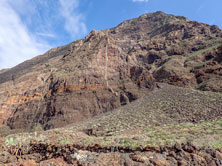|
Home
Page 1/6
Page 2/6
Page 3/6 (this page)
Page 4/6
Page 5/6
Page 6/6
|
El Hierro, the youngest Canary.
Island of landslides
webpage 3/6
Text: Annemieke van Roekel, geoscience journalist
www.vuurberg.nl.
This article was first published in Gea Magazine (September 2022).
Old volcanoes
El Hierro is made up of three volcanic complexes that largely overlap, of
which the Tiñor Complex is the oldest which appeared above sea level over a million years ago.
The east side of Tiñor collapsed 880,000 years ago, which must have been
the first (proven) major landslide on El Hierro, with half of the volcanic
structure disappearing beneath the waves.
Starting 550,000 years ago, a new volcanic complex developed in the old Tiñor shear
area: El Golfo-Las Playas (Fig. 6).
The third and final phase of El Hierro's growth includes the recent rifting activity,
which began 170,000 years ago. During this last phase, the flanks
also slid into the ocean. Most of the eruption centers, with concentrations of cinder cones,
are located on the ridges.

Fig. 6. Geosite Fuga de Gorreta (Frontera). The cliff was created by the first landslide
around 130,000 years ago. Here the internal structure of the El Golfo complex is
visible. Vertical dikes cut through the lava layers; a debris fan can be seen in the lower right.
Photo: Annemieke van Roekel.
Young island
The movement of the large landslides, which occurred as a result of rifting, is almost
perpendicular to the ridges. In total, a rock mass of around 450 cubic km must have slid into the ocean,
three times the volume of the island now above water.
By comparison, during the Cumbre Nueva landslide on La Palma, half a million years ago, 200 cubic
km slid into the ocean.
The distinct structure of the three ridges ("dorsales"),
combined with the large-scale landslides, make El Hierro even more interesting for
volcanologists compared to the other Canary Islands. Because El Hierro is a young island,
it is at an early stage of island development; the other islands of the Canary Archipelago
are older and thus more advanced in their island evolution; the later
stages of erosion and volcanic activity there have largely destroyed
or covered the original volcanic complexes.
Page 1/6
Page 2/6
Page 3/6
Page 4/6
Page 5/6
Page 6/6
Copyright: Annemieke van Roekel
Last update: December 28, 2022
|